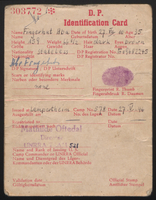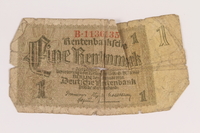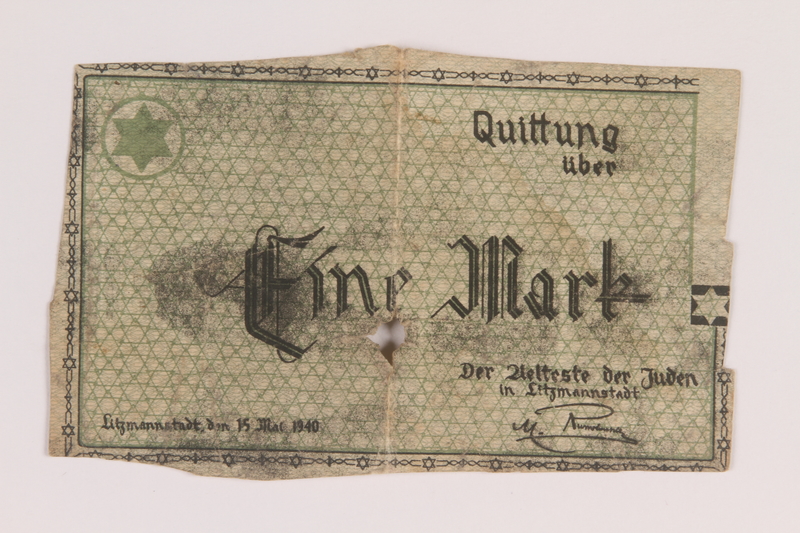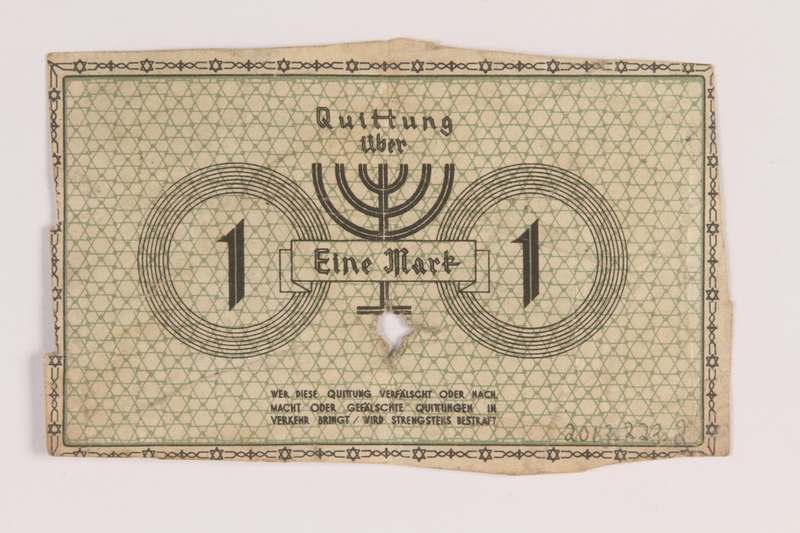Overview
- Brief Narrative
- Łódź (Litzmannstadt) ghetto scrip, 1 mark note, owned by Abe Fingerhut, who was imprisoned in the ghetto from 1940 to 1944. Nazi Germany invaded Poland on September 1, 1939. Łódź was occupied a week later. In February 1940, Abe, his wife and infant son, Jozek, were put in the Jewish ghetto which was closed in with barbed wire. Abe, a tailor, worked in the ghetto textile industry. Conditions were terrible in the ghetto. Jozek died in July 1941. The day before the ghetto was liquidated on August 4, 1944, Abe was sent to Auschwitz. In September, he was transferred to Siegmar-Schoenau labor camp, a subcamp of Flossenbürg, and assigned prisoner number 26495. In January 1945, he was marched to Hohenstein-Ernstthal labor camp. Abe was liberated by Soviet troops on May 7, 1945, on a death march to Flossenbürg. He returned to Łódź and discovered that paretns and wife had been killed. Abe and a group of other survivors, feellng threatened by the Soviet occupation, fled west. Abe went to Lampertheim displaced persons camp in Germany and emigrated to the United States in 1947.
- Date
-
issue:
1940 May 15
received: after 1940 May-before 1944 August
- Geography
-
issue:
Litzmannstadt-Getto (Łódź, Poland);
Łódź (Poland)
received: Litzmannstadt-Getto (Łódź, Poland); Łódź (Poland)
- Credit Line
- United States Holocaust Memorial Museum Collection, Gift of Diane Finger
- Markings
- face, upper right, black ink : Quittung / über [Receipt for about]
face, center, black ink : Eine Mark [One Mark]
face, bottom, black ink : Der Aelteste der Juden / in Litzmannstadt / M. Rumkowski / Litzmannstadt , den 15 Mai 1940 [The Eldest of the Jews / M. Rumkowski / on May 15, 1940]
back, black ink : Quittung / über / Eine Mark [Receipt for about one mark]
back, bottom, black ink : WER DIESE QUITTUNG VERFÄLSCHT ODER NACH. / MACHT ODER GEFÄLSCHTE QUITTUNGEN IN / VERKEHR BRINGT WIRD STRENGSTENS BESTRAFT [ANYONE WHO FALSIFIES OR COPIES THIS RECEIPT, OR TRAFFICS IN COUNTERFEIT RECEIPTS, WILL BE STRICTLY PUNISHED] - Contributor
-
Issuer:
Der Aelteste der Juden in Litzmannstadt
Subject: Albert Finger
- Biography
-
Abe Fingerhut was born on December 27, 1910, in Łódź, Poland, to Samuel and Chana Fingerhut. He was the second of four children, an older and younger sister, and a brother Josef. They were from a shtetl, Averchek (?), a small town with a large Jewish population, and had relocated to Łódź for job opportunities in the large textile industry. As a child, Abe had been recruited to sing with the Yiddish theater star, Molly Picon, and in Łódź, he sang at the Reform synagogue. Abe attended a Jewish high school and spoke Hebrew, Yiddish, Polish, German, and Russian. He worked in the textile industry as a tailor. He met his wife in 1930, but they could not marry until her older sister, who had left for Palestine, wed in Tel Aviv. The family had Zionist sympathies and in 1933, Abe’s younger sister immigrated to Palestine, joining an aunt and uncle already there. Abe and his wife had a son Josek, born on July 8, 1939. They lived in a mixed neighborhood in Łódź and were connected to both the Jewish and Polish societies.
On September 1, 1939, Germany invaded Poland. Jews in Łódź began to experience persecution almost immediately. In February 1940, the ghetto was created. Abe and his family were put in the ghetto, where Abe worked in the ghetto textile industry. On May 1, 1940, the ghetto was sealed with barbed wire fencing. On July 9, 1941, Josek, age 2, died. When the ghetto was being evacuated, Abe attempted to bribe a guard to take care of his parents. Abe remained in Łódź until the day before the ghetto was liquidated on August 4, 1944, when he was sent to Auschwitz. On September 10, 1944, Abe was deported to Siegmar-Schoenau labor camp, a subcamp of Flossenbürg concentration camp, and assigned prisoner number 26495. In January 1945, the prisoners were forced to march to Hohenstein-Ernstthal labor camp. The camp was evacuated in April and the prisoners marched toward Flossenbürg. On May 7, 1945, the day Germany surrendered, Abe was liberated by Soviet forces in Luditz (Zlutice, Czech Republic).
Abe’s family perished in the Holocaust. His wife was deported to be a forced laborer and the family believed she was sent to Stutthof and died on a ferry that sank. Abe’s parents, Samuel and Chana, were deported to Chelmno killing center. After liberation, Abe returned to Łódź and lived with a group of survivors. He dug up family photographs that he had buried. Over time, he began to feel threatened by the Soviet occupation and people started to disappear. They decided to flee west and register as displaced persons. Abe went to Lampertheim displaced persons camp in Germany. On July 1, 1947, he left for Bremen, where he boarded the SS Marine Marlin on July 8, arriving in New York on July 17. His emigration was sponsored by his uncle, Harris Kleinfeld, who lived in Brooklyn. Shortly after arriving, he moved to Chelsea, Massachusetts, to stay with distant cousins. He worked in a haberdashery. He Americanized his name to Albert Finger. He married in 1949 and had two children. The family settled in Quincy, MA, where Albert purchased a tailor shop. He retired in 1973 and moved to Florida in 1976. Albert, age 80, died on September 1, 1991, in Palm Beach, Florida.
Physical Details
- Language
- German
- Classification
-
Exchange Media
- Category
-
Money
- Object Type
-
Scrip (aat)
- Physical Description
- Irregularly cut offwhite paper scrip printed in green ink with black text. On the face is a rectangle with a border of barbed wire interspersed with Stars of David. The inside has a background of interlocked Jewish stars with a large star in a circle in the upper left corner and a smaller one in a black square in the center of the right side border. Across the center is the denomination and other German text. The back has a rectangle with a border of barbed wire interspersed with Stars of David. The inside has 2 sets of 8 concentric rings with the numerical denomination in the center. A banner with the textual denomination connects the rings. The banner crosses over a 7-branched candelabrum in the center, with German text above and below. The entire border has been cut off, including the serial number. The scrip is soiled, creased, and has a hole in the center.
- Dimensions
- overall: Height: 2.375 inches (6.032 cm) | Width: 3.750 inches (9.525 cm)
- Materials
- overall : paper, ink
Rights & Restrictions
- Conditions on Access
- No restrictions on access
- Conditions on Use
- No restrictions on use
Keywords & Subjects
- Topical Term
- Concentration camp inmates--Poland--Biography. Death marches--Poland--Biography. Forced labor--Poland--Biography. Holocaust, Jewish (1939-1945)--Poland--Łódź--Personal narratives, Jewish. Holocaust survivors--United States--Biography. Jewish ghettos--Poland--Łódź. World War, 1939-1945--Conscript labor--Personal narratives, Jewish.
- Geographic Name
- Poland--History--Occupation, 1939-1945.
Administrative Notes
- Legal Status
- Permanent Collection
- Provenance
- The scrip was donated to the United States Holocaust Memorial Museum in 2013 by Diane Finger, the daughter of Albert Finger.
- Funding Note
- The cataloging of this artifact has been supported by a grant from the Conference on Jewish Material Claims Against Germany.
- Record last modified:
- 2022-07-28 18:26:58
- This page:
- https://collections.ushmm.org/search/catalog/irn73584
Also in Albert Finger collection
The collection consists of German currency, Łódź ghetto scrip, documents and a photograph relating to the experiences of Abe Fingerhut during the Holocaust in Łódź, Poland and after the Holocaust in Lampertheim displaced persons camp in Germany.
Date: 1937-1947

Abe Fingerhut papers
Document
The collection includes a photograph of wedding at the Lampertheim displaced persons camp, presided over by Abe Fingerhut, Abe Fingerhut's displaced persons identification card, and one meal ticket. Abe Fingerhut was in the Łódź ghetto and survived multiple concentration camps including Auschwitz and Flossenbürg.

Nazi Germany, 1 Rentenmark note, owned by a former concentration camp prisoner
Object
1937 German 1 (eine) rentenmark note owned by Abe Fingerhut. Nazi Germany invaded Poland on September 1, 1939, and one week later occupied Łódź where Abe lived with his wife and infant son, Jozek. In February 1940, the family was put in the Jewish ghetto which was closed in with barbed wire. Abe, a tailor, worked in the ghetto textile industry. Conditions were terrible in the ghetto: it was extremely overcrowded, food was scarce, and disease and malnutrition were common. Jozek died in July 1941. The day before the ghetto was liquidated on August 4, 1944, Abe was sent to Auschwitz. In September, he was transferred to Siegmar-Schoenau labor camp, a subcamp of Flossenbürg, where he was assigned prisoner number 26495. In January 1945, he was marched to Hohenstein-Ernstthal labor camp. Abe was liberated by Soviet troops on May 7, 1945, on a forced march to Flossenbürg. He returned to Łódź and discovered that his parents, Samuel and Chana, had been sent to Chelmno killing center and his wife died while in forced labor service. Abe lived with a group of other survivors, but they felt threatened by the Soviet occupation and fled west. Abe went to Lampertheim displaced persons camp in Germany. He emigrated to the United States in 1947.





